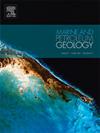Oil–reservoir correlation: Unravelling the producing reservoir for the sulfur-rich Qianjiang shale oil play
IF 3.7
2区 地球科学
Q1 GEOSCIENCES, MULTIDISCIPLINARY
引用次数: 0
Abstract
The hypersaline Qianjiang shale oil play represents a promising yet challenging target for exploration due to its multiple stacked shale-carbonate layers, which complicate the identification of the most viable extraction sites. Additionally, the oil accumulated in these layers is immature to low-mature and considerably high in sulphur content. To trace the shale zones after fracturing, a newly developed oil-reservoir correlation method employing Fourier transform ion cyclotron resonance mass spectrometry (FT-ICR MS) was utilised. This method proved effective in distinguishing between the acidic nitrogen-, sulphur-, and oxygen-containing (NSO) compounds identified by the negative mode of electrospray ionisation FT-ICR MS and the less polar NSO compounds and aromatic hydrocarbons detected by positive ion atmospheric pressure photoionisation FT-ICR MS. These compounds facilitated the deconvolution of oils produced from mixed layers in the hypersaline Qianjiang shale play. The zones of oil production identified through this method corresponded well with shale reservoirs previously characterised by anomalously high oil saturation index values (OSI >400 mg/g TOC) and a preferential enrichment of saturated hydrocarbons. A detailed analysis of C31-35 homohopane distributions in shale extracts and crude oil corroborated these findings. The variability in the producibility of NSO compounds and aromatic hydrocarbons was examined based on functional group, degree of aromatisation, and molecular weight. During production, sulphur- and nitrogen-containing compounds predominantly migrated into the produced oil, whereas oxygen-containing compounds were less affected. Nonetheless, determining the production partitioning of aromatic hydrocarbons remains challenging; if present, it may be obscured by the commingled production effects from multiple layers.
求助全文
约1分钟内获得全文
求助全文
来源期刊

Marine and Petroleum Geology
地学-地球科学综合
CiteScore
8.80
自引率
14.30%
发文量
475
审稿时长
63 days
期刊介绍:
Marine and Petroleum Geology is the pre-eminent international forum for the exchange of multidisciplinary concepts, interpretations and techniques for all concerned with marine and petroleum geology in industry, government and academia. Rapid bimonthly publication allows early communications of papers or short communications to the geoscience community.
Marine and Petroleum Geology is essential reading for geologists, geophysicists and explorationists in industry, government and academia working in the following areas: marine geology; basin analysis and evaluation; organic geochemistry; reserve/resource estimation; seismic stratigraphy; thermal models of basic evolution; sedimentary geology; continental margins; geophysical interpretation; structural geology/tectonics; formation evaluation techniques; well logging.
 求助内容:
求助内容: 应助结果提醒方式:
应助结果提醒方式:


